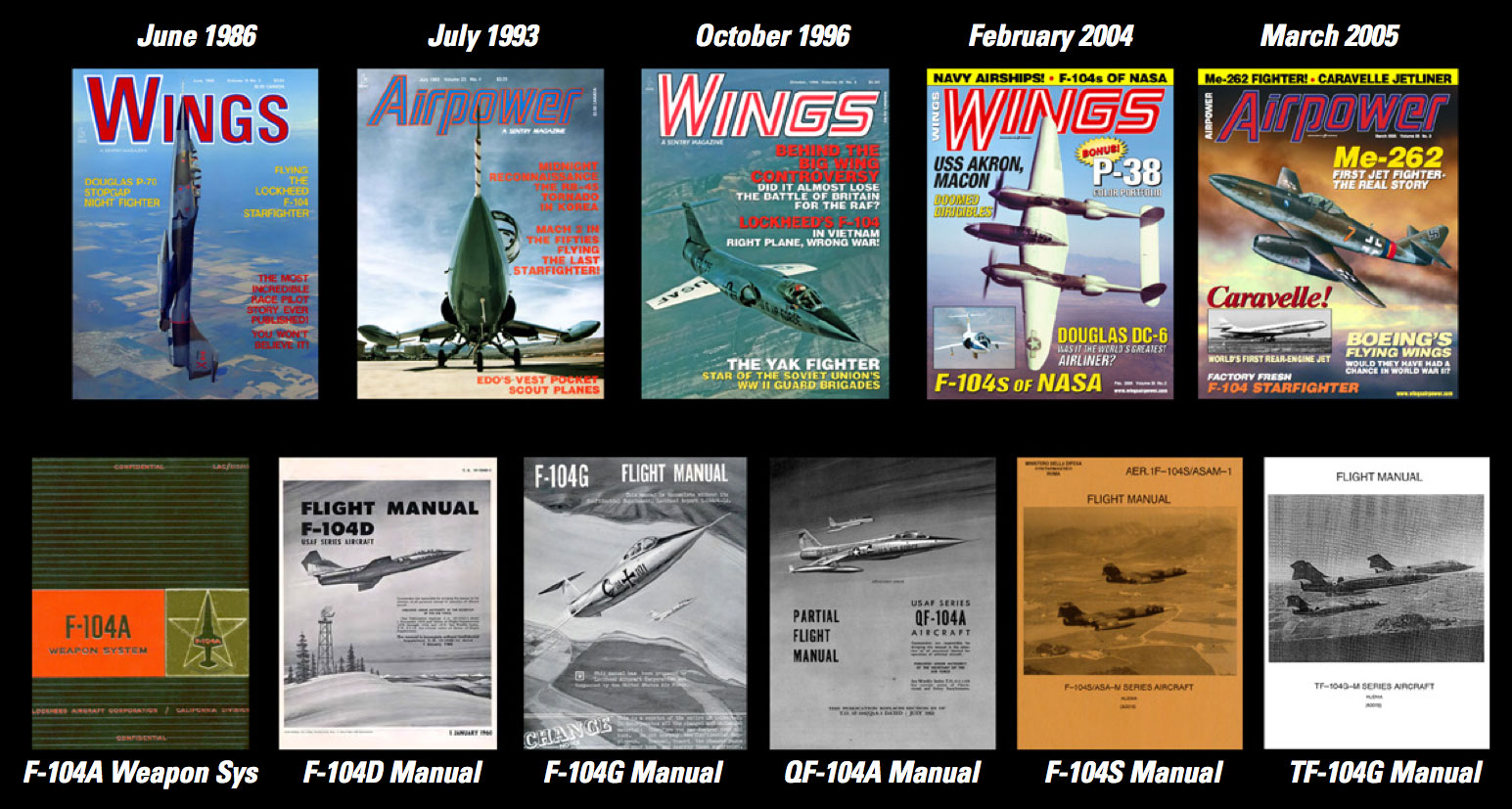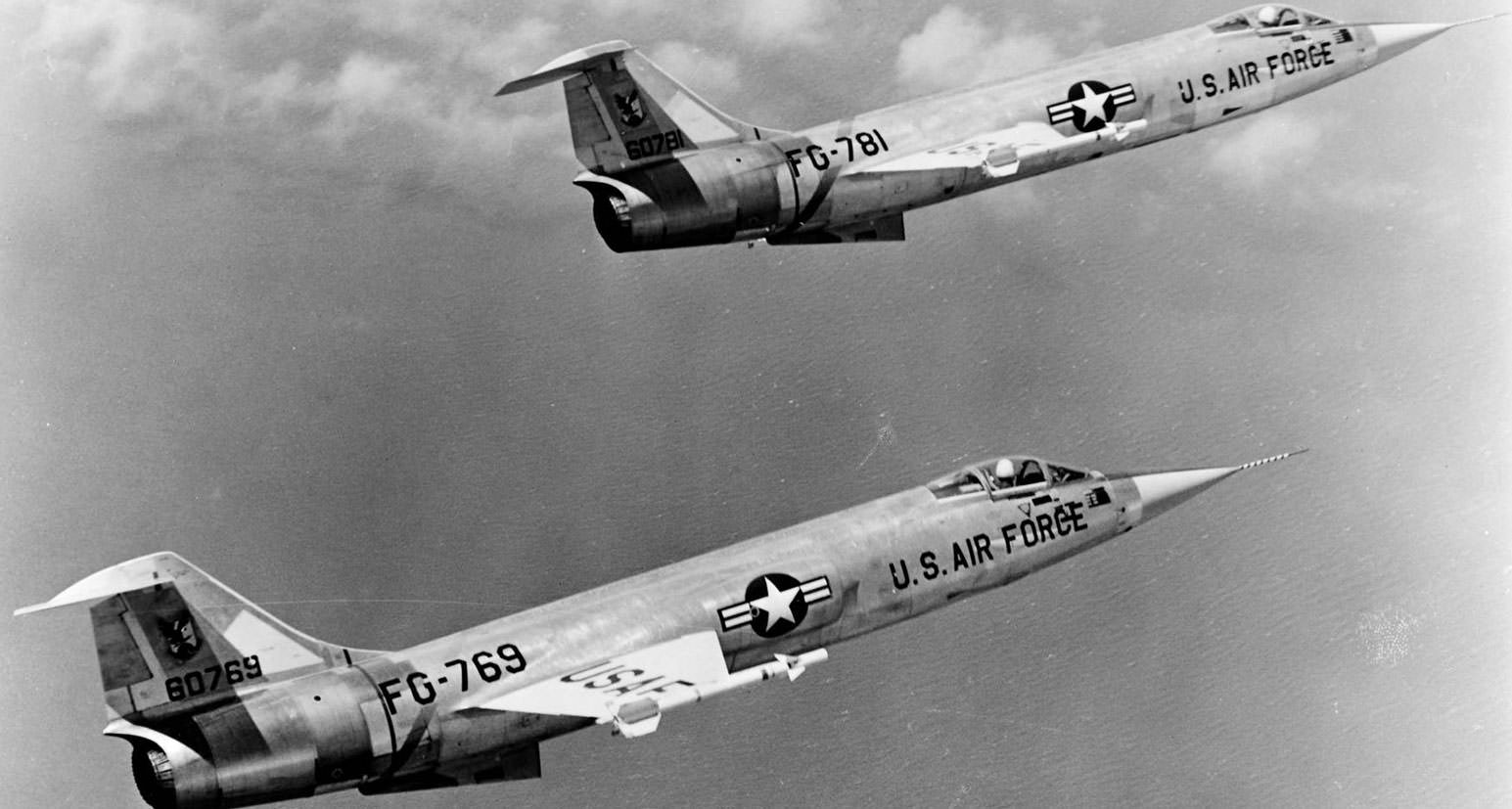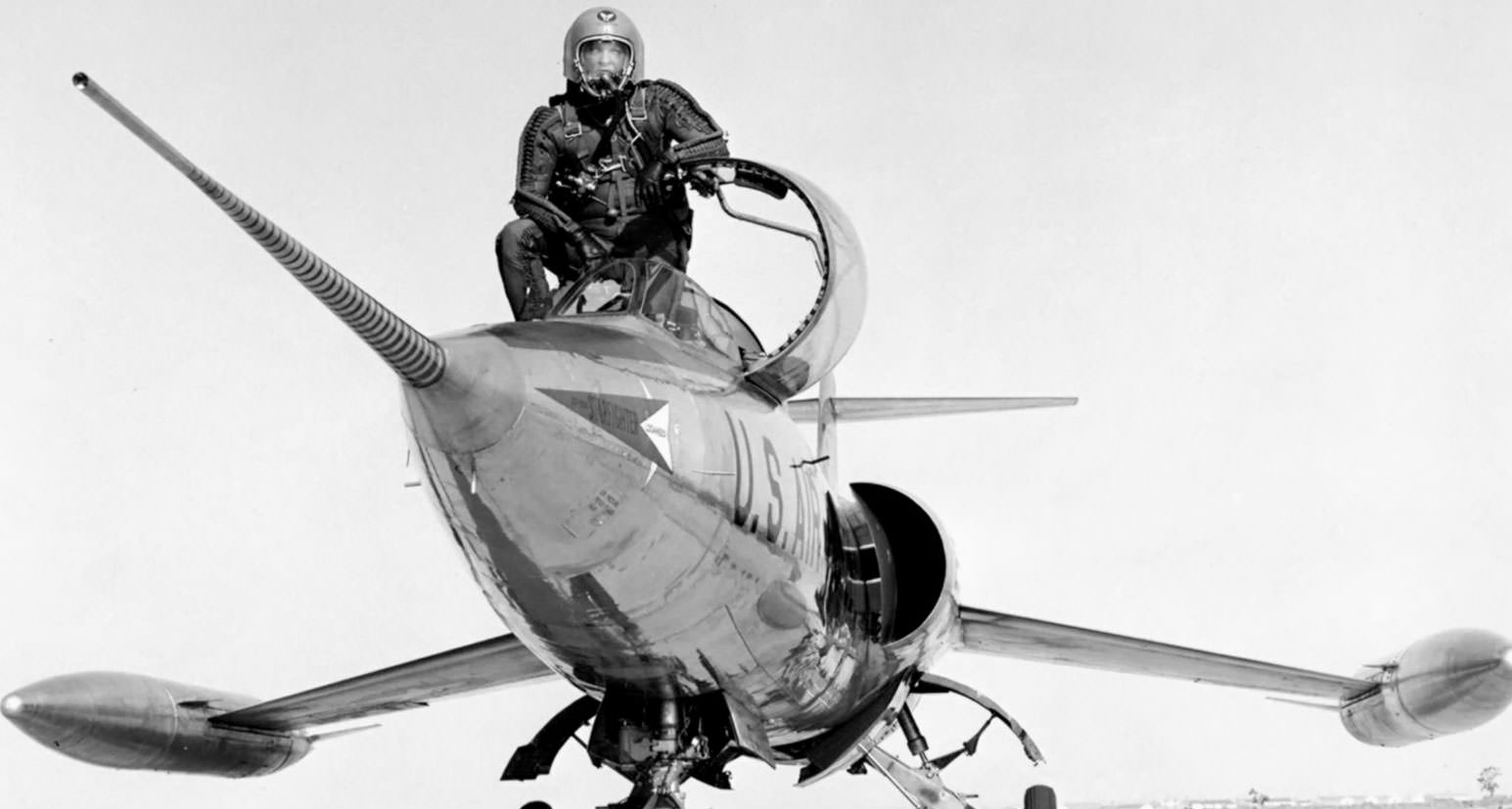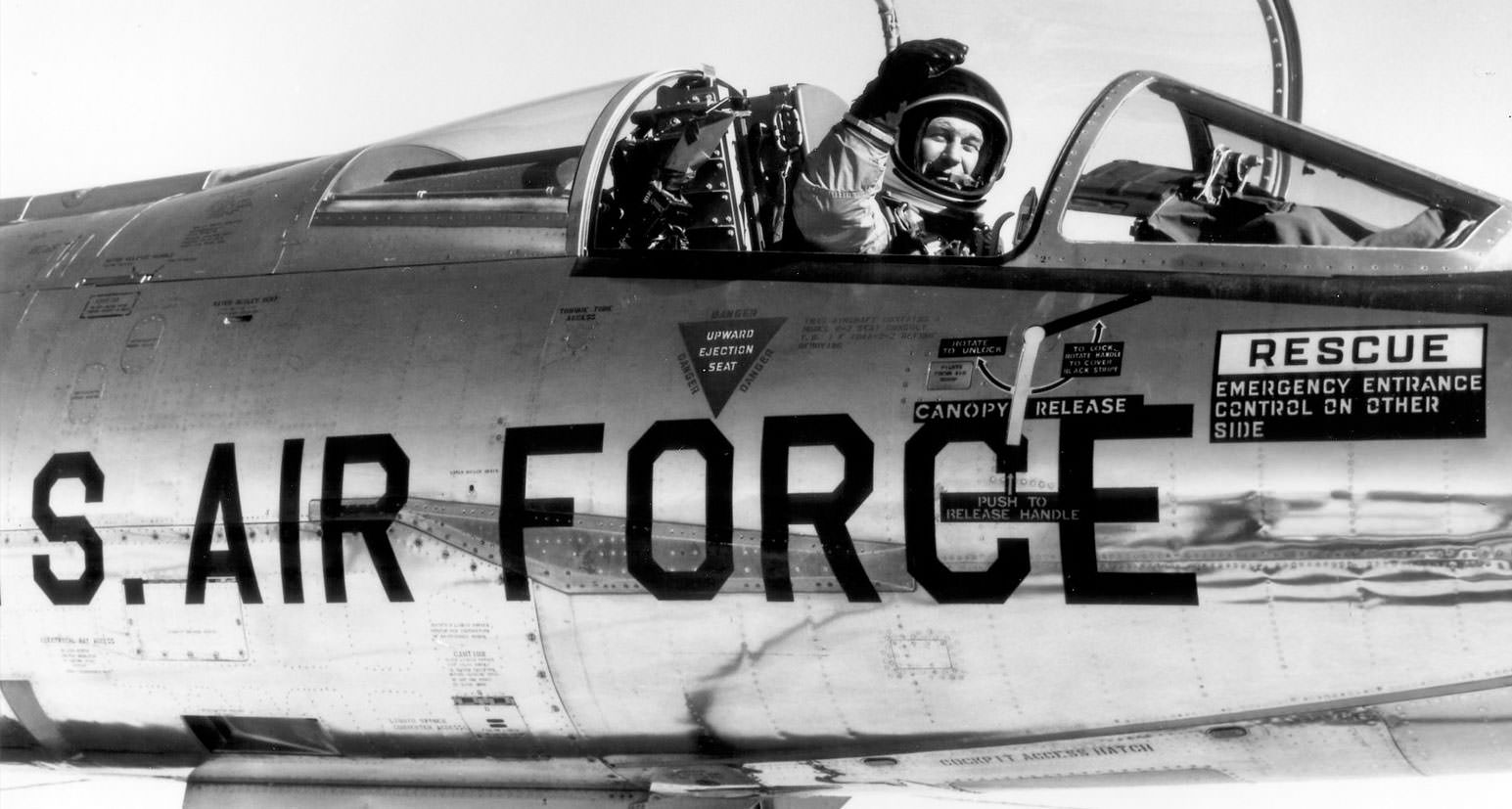Price: $24.95
- 5 magazines, 8 manuals, & photos
- PDF contains 3,180 pages
- Content is keyword searchable
- Print a personal copy
- Pay via PayPal or Credit Card
- International orders welcome!
- Download files upon payment
June 1986
- Flying the Lockheed F-104 Starfighter
- Douglas P-70 Night Fighter
- The most incredible race pilot story ever published!
July 1993
- Mach 2 in the Fifties, Flying the Last Starfighter
- The RB-45 Tornado in Korea
October 1996
- Lockheed’s F-104 in Vietnam, Right plane wrong war!
- Behind the Big Wing Controversy
- The Yak Fighter, Star of the Soviet Union’s WWII Guard Brigades
February 2004
- NASA F-104 Starfighters
- USS Akron & Macon, Doomed Dirigibles
- Douglas DC-6, was it the World’s Greatest Airliner?
March 2005
- F-104 Starfighter, Factory Fresh
- Me-262, First Jet Fighter
- Caravelle! World’s First Rear-Engine Jet
- Boeing’s Flying Wings
F-104 Manuals
- F-104A Weapon System 1957
- F-104A/B/C/D Flight Manual 1966
- F-104B Flight Manual 1958
- F-104D Flight Manual 1960
- F-104G Flight Manual 1961
- F-104S Flight Manual 1996
- QF-104 Flight Manual 1966
- TF-104 Flight Manual 1996
- and over 200 F-104 photos!
Lockheed F-104 Starfighter
F-104G Specs
Variants
On Display
Cutaway
General Characteristics
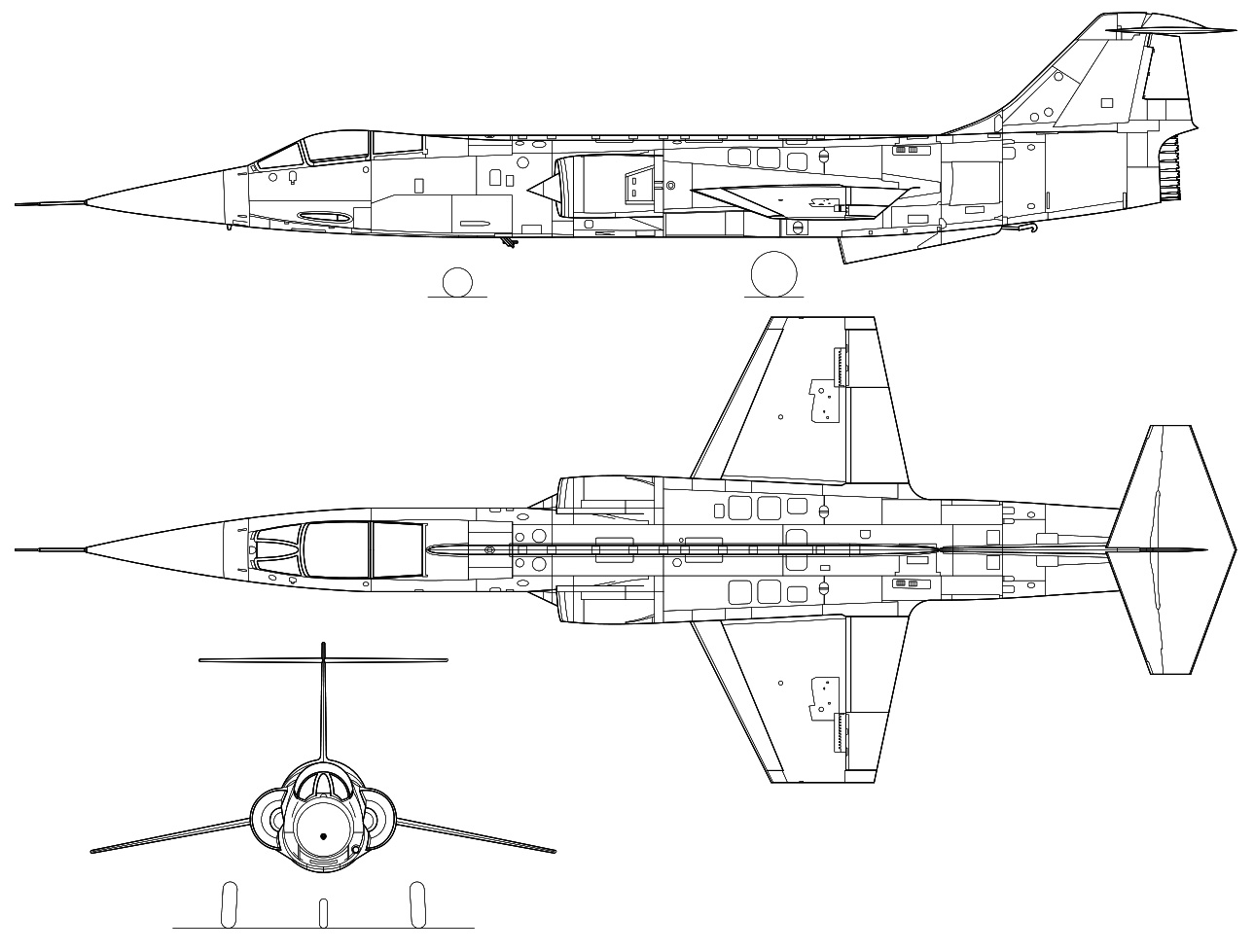
- Crew: 1
- Length: 54 ft 8 in (16.66 m)
- Wingspan: 21 ft 9 in (6.36 m)
- Height: 13 ft 6 in (4.09 m)
- Wing area: 196.1 ft² (18.22 m²)
- Airfoil: Biconvex 3.36% root and tip
- Empty weight: 14,000 lb (6,350 kg)
- Loaded weight: 20,640 lb (9,365 kg)
- Max. takeoff weight: 29,027 lb (13,170 kg)
- Powerplant: 1 × General Electric J79-GE-11A afterburning turbojet
- Dry thrust: 10,000 lbf (48 kN)
- Thrust with afterburner: 15,600 lbf (69 kN)
- Zero-lift drag coefficient: 0.0172
- Drag area: 3.37 sq ft (0.31 m²)
- Aspect ratio: 2.45
Performance
- Maximum speed: 1,328 mph (Mach 2.01, 1,154 kn, 2,137 km/h)
- Combat radius: 420 mi (365 nmi, 670 km)
- Ferry range: 1,630 mi (1,420 nm, 2,623 km)
- Service ceiling: 50,000 ft (15,000 m)
- Rate of climb: 48,000 ft/min (244 m/s)
- Wing loading: 105 lb/ft² (514 kg/m²)
- Thrust/weight: 0.54 with max. takeoff weight (0.76 loaded)
- Lift-to-drag ratio: 9.2
Armament
- Guns: 1 × 20 mm (0.787 in) M61A1 Vulcan 6-barreled Gatling cannon, 725 rounds
- Hardpoints: 7 with a capacity of 4,000 lb (1,814 kg) and provisions to carry combinations of:
- Missiles: 4 × AIM-9 Sidewinder
- Other: Bombs, rockets, or other stores
XF-104
Two prototype aircraft equipped with Wright J65 engines (the J79 was not yet ready); one aircraft equipped with the M61 cannon as an armament test bed. Both aircraft were destroyed in crashes.
YF-104A
A Lockheed YF-104A, AF ser. no. 55-2961, NASA aircraft number 818. First NASA flight on 27 August 1956, last operational flight on 26 August 1975 – 1,439 flights over this period.
17 pre-production aircraft used for engine, equipment, and flight testing. Most were later converted to F-104A standard.
F-104A
A total of 153 initial production versions were built. The F-104A was in USAF service from 1958 through 1960, then transferred to ANG until 1963 when they were recalled by the USAF Air Defense Command for the 319th and 331st Fighter Interceptor Squadrons. Some were released for export to Jordan, Pakistan, and Taiwan, each of whom used it in combat. In 1967 the 319th F-104As and Bs were re-engined with the J79-GE-19 engines with 17,900 lbf (79.6 kN) of thrust in afterburner; service ceiling with this engine was in excess of 73,000 ft (22,250 m). In 1969, all the F-104A/Bs in ADC service were retired. On 18 May 1958, an F-104A set a world speed record of 1,404.19 mph (2,259.82 km/h).
NF-104A
Three demilitarized F-104A airframes with an additional 6,000 lbf (27 kN) Rocketdyne LR121/AR-2-NA-1 rocket engine and modified systems, used for astronaut training at altitudes up to 120,800 ft (36,820 m).
QF-104A
A total of 22 F-104As converted into radio-controlled drones and test aircraft.
F-104B
Tandem two-seat, dual-control trainer version of F-104A, 26-built. Enlarged rudder and ventral fin, no cannon and reduced internal fuel, but otherwise combat-capable. A few were supplied to Jordan, Pakistan and Taiwan.
F-104C
F-104C at the National Museum of the United States Air Force, Wright-Patterson AFB, OH.
Fighter-bomber version for USAF Tactical Air Command, with improved fire-control radar (AN/ASG-14T-2), centerline and two wing pylons (for a total of five), and ability to carry one Mk 28 or Mk 43 nuclear weapon on the centerline pylon. The F-104C also had in-flight refuelling capability. On 14 December 1959, an F-104C set a world altitude record of 103,395 ft (31,515 m), 77 built.
F-104D
Dual-control trainer versions of F-104C, 21 built.
F-104DJ
Dual-control trainer version of F-104J for Japanese Air Self-Defense Force, 20 built by Lockheed and assembled by Mitsubishi.
F-104F
Dual-control trainers based on F-104D, but using the upgraded engine of the F-104G. No radar, and not combat-capable. Produced as interim trainers for the Luftwaffe. All F-104F aircraft were retired by 1971; 30 built.
F-104G
A German RF-104G in flight with a 66th TRW RF-101C.
1,122 aircraft of the main version produced as multi-role fighter-bombers. Manufactured by Lockheed, and under license by Canadair and a consortium of European companies which included Messerschmitt/MBB, Dornier, Fiat, Fokker and SABCA. The type featured strengthened fuselage and wing structure, increased internal fuel capacity, an enlarged vertical fin, strengthened landing gear with larger tires and revised flaps for improved combat maneuvering. Upgraded avionics included a new Autonetics NASARR F15A-41B radar with air-to-air and ground mapping modes, the Litton LN-3 Inertial Navigation System (the first on a production fighter) and an infrared sight.
RF-104G
189 tactical reconnaissance models based on F-104G, usually with three KS-67A cameras mounted in the forward fuselage in place of cannon.
TF-104G
220 combat-capable trainer version of F-104G; no cannon or centerline pylon, reduced internal fuel. One aircraft used by Lockheed as a demonstrator with the civil registration number L104L, was flown by Jackie Cochran to set three women’s world speed records in 1964. This aircraft later served in the Netherlands. A pair of two-seat TF-104Gs and a single-seat F-104G joined the Dryden inventory in June 1975.
F-104H
Projected export version based on a F-104G with simplified equipment and optical gunsight. Not built.
F-104J
Specialized interceptor version of the F-104G for the Japanese ASDF, built under license by Mitsubishi for the air-superiority fighter role, armed with cannon and four Sidewinders; no strike capability. Some were converted to UF-104J radio-controlled target drones and destroyed. Total of 210 built, three built by Lockheed, 29 built by Mitsubushi from Lockheed built components and 178 built by Mitsubishi.
F-104N
Three F-104Gs were delivered to NASA in 1963 for use as high-speed chase aircraft. One, piloted by Joe Walker, collided with an XB-70 on 8 June 1966.
F-104S (Lockheed Model CL-901)
F-104S in original camouflage scheme with Sparrow missiles mounted under the wings, c. 1969
Produced mainly by Fiat and Aeritalia (one aircraft was lost before delivery), upgraded for the interception role having NASARR R-21G/H radar with moving target indicator and continuous wave illuminator for SARH missiles (initially AIM-7 Sparrow), two additional wing and two underbelly hardpoints (to give a total of nine), uprated J79-GE-19 engine with 52.8 kN (11,870 lbf) thrust (79.6 kN/17,900 lbf with afterburner), and two additional ventral fins for increased stability at high Mach numbers.
Up to two Sparrow; and two, theoretically four or six, Sidewinder missiles were carried on all the hardpoints except the central (underbelly), or seven 340 kg (750 lb) bombs (normally, two-four 227–340 kg/500-750 lb). Range was up to 1,250 km (777 mi) with four tanks, ferry range 2,940 km (1,827 mi).
Aircraft allocated to air defence missions had their 20 mm (.79 in) M-61 Vulcan cannon removed. The F-104S was cleared for a higher maximum takeoff weight, allowing it to carry up to 7,500 lb (3,400 kg) of stores; other Starfighters had a maximum external load of 4,000 lb (1,814 kg). With four under wing drop tanks range was up to 780 mi (1,250 km). Production of the F-104S totalled 286, with the Italian Air Force taking delivery of 246 and the Turkish Air Force receiving 40 aircraft.
F-104S-ASA
(Aggiornamento Sistemi d’Arma – “Weapon Systems Update”) – An upgraded F-104S, 147 were modified from existing airframes, with Fiat R21G/M1 radar with frequency hopping, look-down/shoot-down capability, new IFF and weapons delivery computer, and provision for AIM-9L all-aspect Sidewinder and Selenia Aspide missiles.
Due to the delays of Aspide integration, the initial version, with Raytheon AIM-7 Sparrows was designated ASA-1. When the Aspide became available, all F-104Ss were upgraded to ASA-2 standard. First flown in 1985 the F-104S-ASA was principally an air-defence aircraft without enhancements to ground attack capabilities and were later modified to interceptor standards (CI) with removal of the 20 mm (.79 in) M-61 Vulcan cannon.
F-104S-ASA/M
(Aggiornamento Sistemi d’Arma/Modificato – “Weapon Systems Update/Modified”) – 49 F-104S-ASA and 15 two-seat TF-104G aircraft upgraded from 1998 to ASA/M standard with GPS, new TACAN and Litton LN-30A2 INS, refurbished airframe, and improved cockpit displays.
All strike-related equipment was removed, including the IRST (the small unit known as ‘IR-Sight’, forward the windshield). The last Starfighters in combat service, the F-104S-ASA/M was withdrawn in October 2004 (the last unit being 10° Gruppo/9° Stormo, Grazzanise), and temporarily replaced by F-16 Fighting Falcons, whilst awaiting delivery of Eurofighter Typhoons.
CF-104
200 Canadian-built versions, built under license by Canadair and optimized for both nuclear strike and 2-stage-to-orbit payload delivery, having NASARR R-24A radar with air-to-air modes, cannon deleted (restored after 1972), additional internal fuel cell, and Canadian J79-OEL-7 engines with 10,000 lbf (44 kN)/15,800 lbf (70 kN) thrust.
CF-104D
38 dual-control trainer versions of CF-104, built by Lockheed, but with Canadian J79-OEL-7 engines. Some later transferred to Denmark, Norway and Turkey.
Belgium
- F-104G
- 26+47 German Air Force – at company at Tessenderlo.
- FX04 Belgian Air Force – 1st Wing Historical Center at Beauvechain Air Base.
- FX12 Belgian Air Force – Royal Museum of the Armed Forces and Military History, Brussels.
- FX15 Belgian Air Force – stored at the 1st Wing Historical Center at Beauvechain Air Base.
- FX21 Belgian Air Force – Headquarters of the Belgian Air Force at Evere.
- FX39 Belgian Air Force – stored with the 10th Tactical Wing at Kleine Brogel.
- FX47 Belgian Air Force – 1st Wing Historical Center at Beauvechain Air Base.
- FX53 Belgian Air Force – gate-guard at the Technical School of the Air Force, Saffraanberg near Sint-Truiden.
- FX61 Belgian Air Force – stored with the 10th Tactical Wing at Kleine Brogel.
- FX76 Belgian Air Force – stored at a factory next to the E40 Motorway at Zaventem.
- FX79 Belgian Air Force – top of a sea container at a scrap dealer next to the E3 Motorway at Lochristi-Beervelde.
- FX86 Belgian Air Force – front of the officers mess at the 10th Tactical Wing at Kleine Brogel.
- FX94 Belgian Air Force – on a roundabout at the N73-Kiezel Kleine-Brogel in front of the Belgian Air Base Kleine Brogel.
Canada
- CF-104A
- 12700 – Canadian Aviation Museum, Ottawa, Ontario.
- CF-104D
- 12645 – Canadian Museum of Flight, Langley, British Columbia.
- 12646 – National Air Force Museum of Canada, Astra, Ontario.
- 12652 – Canadian Forces Staff College, Toronto, Ontario.
- 104651 – Alberta Aviation Museum, Edmonton, Alberta.
- 104783 – Atlantic Canada Aviation Museum.
- F-104G
- FX99 Belgian Air Force – preserved/stored with International Vintage Aircraft at Markham, Ontario.
- TF-104G
- D-5805 Royal Netherlands Air Force – Alberta Aviation Museum.
Czech Republic
- F-104G
- FX93 Belgian Air Force – Air Park Zru? u Plzn?.
France
- 22+40 German Air Force – Musée de l’Air et de l’Espace, Le Bourget Airport, Paris.
- 21+91 German Air Force – Ailes Anciennes Toulouse.
- FX90 Belgian Air Force – Savigny-lès-Beaune.
- TF-104G
- FC08 Belgian Air Force – Savigny-lès-Beaune.
Germany
- F-104F
- 29+03 – Deutsches Museum Flugwerft Schleissheim at Oberschleißheim in the northern suburbs of Munich.
- F-104G
- 20+07 – Wernigerode.
- 20+37 – Luftwaffenmuseum der Bundeswehr at Berlin-Gatow
- 20+43 – Flugausstellung Hermeskeil.
- 20+45 – Aviation Museum Hannover-Laatzen at Hannover.
- 20+81 (painted as 23+81) – at the air base in Schleswig, Schleswig-Holstein, Germany
- 21+53 – Deutsches Museum at Munich.
- 21+56 – Luftfahrt- und Technik-Museumspark Merseburg.
- 22+45 – Wernigerode.
- 22+49 – Sinsheim Auto & Technik Museum.
- 22+58 – “Traditionsgemeinschaft JaboG-34”, in Memmingen, Germany.
- 23+90 (Marineflieger) – Wernigerode.
- 25+49 – Wernigerode (front fuselage only).
- 26+49 – Luftwaffenmuseum der Bundeswehr at Berlin-Gatow
- 26+53 – Technikmuseum Speyer.
- DB+127 ZLL – Luftwaffenmuseum der Bundeswehr at Berlin-Gatow
- FX60 Belgian Air Force – preserved at the Flugausstellung Hermeskeil
- F-104G-CCV
- 98+36 German Air Force – Wehrtechnische Studiensammlung Collection for studying military engineering, Koblenz.
- TF-104G
- 27+90 – Luftwaffenmuseum der Bundeswehr at Berlin-Gatow
- 29+06 – Luftwaffenmuseum der Bundeswehr at Berlin-Gatow
Greece
- F-104G
- FX52 Belgian Air Force – Palis Foundation at Karelias Koropiou, Greece.
- FG-6695 Hellenic Air Force – Athens War Museum, Greece.
- s/n unknown Hellenic Air Force Museum, named “Tiger”
- s/n unknown Hellenic Air Force Museum, named “Olympus”
Hungary
- F-104G
- 21+64 German Air Force – Hungarian Museum of Hungarian Aviation, Szolnok.
- CF-104G
- 104893 (63-893) (Ex-RCAF) – Hungarian Museum of Hungarian Aviation, Szolnok. The last operator was the Turkish Air Force.
Italy
- The Italian Air Force was a major user of F-104s, and the last air force to withdraw the aircraft from its front line. More than 100 F-104s are in display in Italy.
Japan
- 36-8515 JASDF – Kakamigahara Aerospace Museum, Kakamigahara, Gifu.
- 36-8552 JASDF – Family Spot Park in Chippubetsu, Hokkaid?, near Hokkaido AFB.
- 36-8687 JASDF – Top of a mountain in Okayama.
- JASDF – gateguard at Chitose Air Base
Netherlands
- F-104G
- 21+71 German Air Force – stored with PS Aero at Baarlo.
- 22+90 German Air Force – stored with PS Aero at Baarlo.
- 24+63 German Air Force – stored with PS Aero at Baarlo, painted as ‘D-8212’ (Royal Netherlands Air Force).
- 26+02 German Air Force Schagen factory at Hasselt, Painted as ‘D-8029’
- 26+72 Marineflieger – stored with PS Aero at Baarlo.
- D-8022 Royal Netherlands Air Force – Militaire Luchtvaart Museum, Soesterberg.
- D-8114 Royal Netherlands Air Force – stored with the Militaire Luchtvaart Museum, Soesterberg.
- D-8245 Royal Netherlands Air Force – gateguard at the Militaire Luchtvaart Museum, Soesterberg.
- D-8268 Royal Netherlands Air Force – gateguard at Deltion College, Zwolle.
- FX45 Belgian Air Force – Autosloperij Ad Stouten, Oosterland, Zeeland, painted as ‘D-8030’ Royal Netherlands Air Force.
- FX69 Belgian Air Force – fuselage stored at Kessel, Limburg.
- KG-101 (German Air Force – stored at PS Aero at Baarlo.
Norway
- TF-104G
- 63-8469 – Norwegian Armed Forces Aircraft Collection.
Pakistan
- F-104B
- 57-1309 (ex-USAF) – Pakistan Air Force Museum, in Karachi.
Poland
- F-104S
- MM 6876/5-47 (Italian Air Force) – Polish Aviation Museum, in Kraków.
Slovakia
- F-104S
- 6870/5-45 Italian Air Force – Aviation Museum in Košice (a branch of the Slovak Museum of Technology). Served in the 5th Wing Giuseppe Cenni in Cervia. Retired from the Italian Air Force and donated to the Aviation Museum in Košice in 2004.
Spain
- F-104G
- 26+23 German Air Force – Air Museum of Spain, in Madrid. The aircraft is an ex-Luftwaffemachine which retains its German markings on the left side but is unusually painted with Spanish markings on the right side.
Turkey
- F-104G
- s/n unknown – Middle East Technical University, Ankara.
- F-104S
- s/n unknown – Istanbul Aviation Museum, Istanbul
United Kingdom
- R-756 Royal Danish Air Force – Midland Air Museum, Coventry, England.
- 22+35 German Air Force – Lasham airfield, England, 2006.
- 22+57 German Air Force – Bruntingthorpe Airfield, Leicestershire.
United States
- 55-2961 (NASA N818NA) – hanging from the ceiling of the Smithsonian’s National Air and Space Museum, Washington, D.C.
- 56-0750 – Michigan 104, Canton, Michigan.
- 56-0751 – Nevada County Air Park, Grass Valley, California.
- 56-0753 – Camp Robinson, Little Rock, Arkansas.
- 56-0754 – National Museum of the United States Air Force, Wright-Patterson AFB, Dayton, Ohio.
- 56-0778 – Warhawk Air Museum, Nampa, Idaho.
- 56-0780 (formerly 56-0779) – Cavanaugh Flight Museum, Addison, Texas.
- 56-0790 (NASA N820NA) – USAF Test Pilot School, Edwards Air Force Base, California.
- 56-0817 – Pacific Aviation Museum on loan from Museum of Aviation, Robins AFB, Warner Robins, Georgia.
- F-104B
- 57-1303 (NASA N819NA) – Aerospace Museum of California at the former McClellan AFB in Sacramento, California.
- F-104C
- 56-0886 – Holloman AFB, New Mexico.
- 56-0898 – Kalamazoo Air Zoo, Kalamazoo, Michigan.
- 56-0901 – New England Air Museum, Bradley International Airport. in Windsor Locks, Connecticut.
- 56-0910 – Wings Over the Rockies Air and Space Museum (former Lowry AFB) in Denver, Colorado
- 56-0914 – National Museum of the United States Air Force, Wright-Patterson AFB, Dayton, Ohio.
- 56-0919 – gate guardian at the 165th Air Support Operations Squadron and 224th Joint Communications Support Squadron facility, Georgia Air National Guard, Brunswick, Georgia.
- 56-0926 – Valley City, North Dakota
- 56-0929 – Southern Museum of Flight, Birmingham, Alabama.
- 56-0934 – Museum of Flight in Seattle, Washington.
- 56-0936 (painted as F-104A 56-0808) – Peterson Air and Space Museum, Peterson AFB, Colorado.
- 57-0915 – Joe Davies Heritage Airpark located at Palmdale, CA
- 57-0916 – Virginia Air & Space Center near Langley AFB in Hampton, Virginia.
- 57-0929 – Muniz Air National Guard Base at Luis Muñoz Marín International Airport, San Juan, Puerto Rico.
- F-104D
- 57-1314 (painted as F-104B 57-1312) – Castle Air Museum at the former Castle AFB in Atwater, California.
- 57-1323 – Pima Air and Space Museum adjacent to Davis-Monthan AFB in Tucson, Arizona.
- 57-1331 – Air Force Armament Museum, at Eglin AFB, Florida.
- 57-1332 – Huntington Municipal Airport, in Huntington, Indiana.
- 57-1334 – George Izay Park located at Burbank, California.
- F-104G
- FX-81 (Belgian Air Force, painted as Royal Netherlands Air Force “D-8090”) – The Air Victory Museum, South Jersey Regional Airport, Lumberton, New Jersey.
- FX-82 (Belgian Air Force – Planes of Fame Air Museum, Chino, California.
- KG200 (NASA N826NA) – Dryden Flight Research Center located inside Edwards Air Force Base, California.
- TF-104G
- 61-3065 (NASA N824NA) – Estrella War Birds Museum at Paso Robles, California.
- F-104N (NASA)
- N811NA – Embry-Riddle Aeronautical University Prescott, Arizona campus. It was flown by Neil Armstrong.
- N812NA – Lockheed Martin Skunk Works facility, Palmdale, California.


